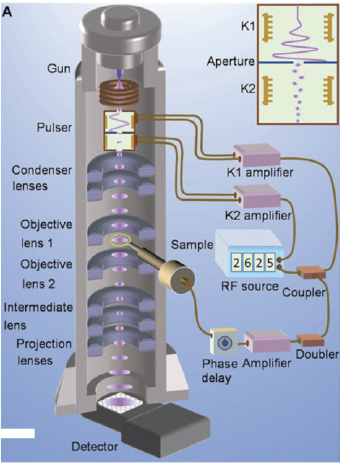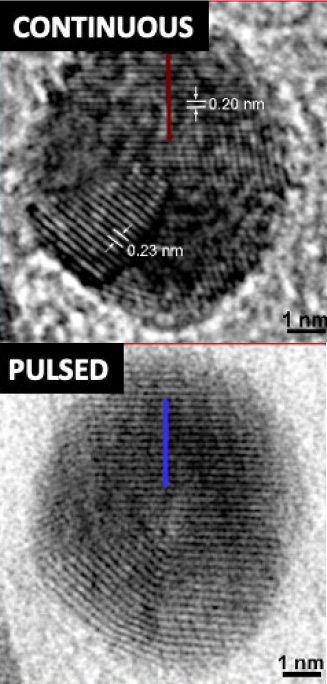Experiments that once took days now take minutes
Get unprecedented data acquisition rates (100-10,000X faster) and high-resolution low-damage images in minutes with wide frequency tunability. Instantly, your conventional TEM is an entirely new stroboscopic or controlled dose instrument.
Euclid’s UltraFast Pulser Module: the low cost, high-performance upgrade
Install the Euclid Ultra Fast Pulser (UFPTM) module to convert any existing or new TEM into an ultrafast instrument that can capture dynamic events in-situ to a space-time resolution of 10 -23 m•s. Based solely on microwave technology, you avoid the drawbacks and high cost of lasers or photocathodes, while maintaining the native instrument performance.
A GHz electron beam pulser with major advantages
Our UPF™ module enables the electron beam to be pulsed with the flip of a switch. The pulsed beam can be adjusted from continuous operation to single electron events at repetition rates up to 12 GHz
- Faster repetition rate means faster data acquisition: high resolution images in minutes with 10pA pulses
- Wide tunability: single-electron pulses to full DC beam current
- Low damage imaging: precise dose control or variable modulation scheme to allow sample relaxation between consecutive pulses
- Cathode independent: maintain existing microscope e-gun and column performance
- One-time installation: module mechanically incorporated into beam path and permanently aligned in EM column
- Low cost of ownership: Module and electronics are a fraction of laser system cost

Ultrafast Pulser {UFP™} integration into TEM. UFP™ main column elements: kicker (K1, K2) and aperture shown in inset. Reprinted with permission from American Association for the Advancement of Science.
Flexibility and new frontiers
The electron gun and core optics of the TEM are unchanged, so you have the flexibility to switch between ‘continuous’ and ‘pulsed’ modes: (1) the standard high spatial resolution imaging mode with UFPTM off, and (2) a high spatio-temporal resolution mode with space-time resolution < 10-22 m·s with the UFP™ on.
This easy, affordable upgrade opens up new frontiers in direct visualization of atomic-scale processes over all frequency ranges with our innovative adaptation of beam physics and RF (radio frequency) technology.
Euclid’s UltraFast Pulser (UFP) versus laser
Besides the cost advantage, our module extends the quantitative methods to measure dynamic properties in situ, offering a complimentary approach to UTEM.
- High pulse repetition rate (up to 12 GHz) outperforms laser technologies. Typical l laser-based UTEMs generally operate around 100 kHz.
- Tunability and large duty cycle. Laser UTEM allows a very small duty cycle
- Lower cost operation. Alignment is done once (by us!) and you spend your time on research, instead of optical alignment & laser care
- Straightforward retrofittable solution
Comparative images
The UTEM field has struggled to retain the spatial resolution of the native TEM when the pulse duration is reduced below a nanosecond. However, the Euclid UltraFast Pulser maintains the TEM image quality There is no degradation of TEM performance as there can be with other solutions, even at sub-nanometer resolution.
Typical Applications: Bright Field & Diffraction Imaging

Comparative bright field (left) and diffraction (right) images of gold nanoparticles on holey carbon film using continuous and pulsed (30 ps width at 5.2 GHz) electron beam. Resolution, contrast and feature position retained within statistical error of image.
Application: High Res Imaging

Comparative high-resolution images of gold nanoparticles on holey carbon film using continuous (top) and pulsed (bottom, 60 ps width at 3 GHz) electron beam. Both images clearly show multiple lattice domains with spacings down to 0.20 nm

Ultrafast TEM instrument comparison

While standard TEM imaging is dependent on the detector capabilities, laser-based UTEM and laser-free UTEM have complementary ranges and therefore capabilities. Laser UTEM parameters are determined by the laser amplifier performance: short pulse length (0.2 to 10 ps) and lower frequency (below 10 MHz) repetition rates, providing a very low duty factor. Laser-free UTEM parameters are determined by the RF pulser frequency range: adjustable pulse length (5 ps to 1 second) and high operating frequency (up to 12 GHz).
Collaborations with industry leaders
Euclid has established close working relationships with all of the EM industry leaders to enable the UFP to be retrofitted across all major TEMs. For example, a Department of Energy contract with a contributing share from Brookhaven National Lab resulted in a successful implementation in a JEOL TEM. Similarly, a National Institutes of Health contract enables researchers to upgrade their ThermoFisher cryoTEM. Euclid continues to collaborate with customers and microscope suppliers, advancing the UFP capabilities. Applications include materials science, life sciences, nanotechnology and semiconductors.

Brookhaven National Lab setup with JEOL TEM

CalTech set up with ThermoFisher TEM
